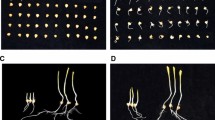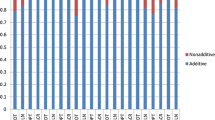Summary
The variation of response to acetochlor was studied in a two-year experiment carried out by subjecting 18 maize (Zea mays L.) inbred lines to three herbicide rates (0, 2.5 and 5 l a.i./ha). In both years some inbred lines consistently exhibited an evident susceptibility, with symptoms consisting of the seedling curling up below the soil surface and causing impaired field emergence. The results were poor plant density and lower grain yield in comparison to control. In contrast, other lines showed a satisfactory level of tolerance.
Then, to gather data on the inheritance of response to acetochlor, four tolerant inbreds (T) and four susceptible inbreds (S) were crossed to obtain four T×T, four S×S, four S×T and the corresponding four T×S two-way hybrids. These hybrids were studied together with parental lines by applying the same herbicide rates used in the previous trial. The S×S hybrids showed susceptibility to the herbicide and the T×T were tolerant, whereas the S×T and the T× S hybrids showed a tolerance very close to that of the T×T hybrids. No difference was found between S×T and the corresponding T×S hybrids as to herbicide response. On average, the 16 hybrids exhibited greater tolerance than the eight parental lines, with each hybrid group being more tolerant than its parental line group. These results indicate that tolerance to acetochlor is prevailingly dominant, that action of extranuclear genes should be ruled out, and that the level of plant vigour can affect herbicide reactiveness.
Similar content being viewed by others
References
Anonymous, 1985. A look at world pesticide market. Farm Chem. 148, 9: 26–34.
Burt B.W., 1976. Factors affecting thiocarbamate injury to corn. II. Soil incorporation, seed placement, cultivar, leaching and breakdown. Weed Sci. 24: 327–330.
Francis T.R. & A.S. Hamill, 1980. Inheritance of maize tolerance to alachlor. Can. J. Plant Sci. 60: 1045–1047.
Grogan C.O., F.E. Emory & R.D. Palmer, 1963. Inheritance of susceptibility of a line of maize to simazine and atrazine. Crop Sci. 3: 451.
Horny, P.E., W.F. Meggitt & M. Barret, 1983. The effect of soil applied herbicides on corn roots and shoots. Proc. North Central Weed Control Conf. 104.
Jugenheimer R.W., F.W. Slife & R.F. Fuelleman, 1948. Stalk lodging in inbred lines of corn caused by 2,4-D spray during flowering. North Central Weed Control Conf. Res. Rep. 3: 68.
Komives, V., T. Komives & F. Dutka, 1984. Influence of herbicides on the glutathione — S — transferase level of maize seedlings. (In Hungarian, English summary). Acta Biochim. et Bioph. Acad. Scient. 19, 1/2, p. 130.
Landi P., P. Catizone & S. Conti, 1981. Comportamento differenziale di linee e ibridi di mais sottoposti a trattamenti diserbanti con Eradicane 6E (EPTC+R 25788). Rivista di Agronomia 15, 2: 85–94.
Leavitt J.R.C. & D. Penner, 1978. Protection of corn (Zea mays) from acetoanilide herbicidal injury with the antidote R-25788. Weed Sci. 26: 653–659.
Leng E.R. & F.W. Slife, 1948. Differential seedling response of corn inbred lines to 2,4-D treatment. Fifth North Central Weed Control Conf. Res. Rep. 8: 7.
Lynn L.B., 1980. Performance of acetochlor in corn and potatoes in the northeastern United States. Proc. Northeastern Weed Sci. Soc. 34: 43–50.
Miklos D., 1981. Comparative analysis of acetochlor and metolachlor based herbicides in the weed control of maize. I. (In Hungarian, English summary). Novenytermeles 30, 2: 145–155.
Narsaiah B.D. & R.G. Harvey, 1977. Differential responses of corn inbreds and hybrids to alachlor. Crop Sci. 17: 657–659.
Poneleit C.G., 1974. Review of thiocarbamate herbicide research and genetic resistance studies. Proc. Annual Corn and Sorghum Res. Conf. 29: 142–152.
Reick C.E. & T.H. Wright, 1973. Differential butylate injury to corn hybrids. Weed Sci. 21: 194–196.
Sagaral E.C. & C.L. Foy, 1982. Responses of several corn (Zea mays L.) cultivars and weed species to EPTC with or without antidote R-25788. Weed Sci. 30: 64–69.
Scott A.J. & M. Knott, 1974. A cluster analysis method for grouping means in the analysis of variance. Biometrics 30, 3: 507–512.
Simkins G.S., L.J. Moshier & O.G. Russ, 1980. Influence of acetamide herbicide applications on efficacy of the protectant CGA-43089 in grain sorghum (Sorghum bicolor). Weed Sci. 28: 646–649.
Author information
Authors and Affiliations
Rights and permissions
About this article
Cite this article
Landi, P., Frascaroli, E. & Catizone, P. Variation and inheritance of response to acetochlor among maize inbred lines and hybrids. Euphytica 45, 131–137 (1990). https://doi.org/10.1007/BF00033280
Issue Date:
DOI: https://doi.org/10.1007/BF00033280




